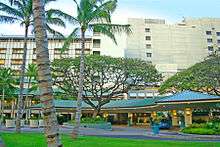The Queen's Medical Center
| The Queen's Medical Center | |
|---|---|
 Front view of The Queen's Medical Center | |
| Geography | |
| Location | Honolulu, Hawaii, United States |
| Organization | |
| Care system | Private |
| Funding | Non-profit hospital |
| Hospital type | Community |
| Services | |
| Emergency department | Level I trauma center |
| Beds | 533 |
| History | |
| Founded | 1859 |
| Links | |
| Website | http://www.queensmedicalcenter.net |
| Lists | Hospitals in Hawaii |
The Queen's Medical Center, originally named and still commonly referred to as Queen's Hospital, is the largest private non-profit hospital in Honolulu, Hawaii. The institution was founded in 1859 by Queen Emma and King Kamehameha IV, and is located in Downtown Honolulu.
Description
Queen's is the largest private hospital in Hawaii, licensed to operate with 505 acute care beds and 28 sub-acute beds. With 3,600 employees—including 1,160 nurses and over 1,100 physicians on staff—it is also one of the state of Hawaii’s largest employers. It is a Level I trauma center and the only designated trauma center in the state of Hawaii, and first Level I in the Pacific. It is located in downtown HonoluluCoordinates: 21°18′26″N 157°51′15″W / 21.30722°N 157.85417°W, southwest of Interstate H-1.
As the leading medical referral center in the Pacific Basin, Queen's is widely known for its programs in cancer, cardiovascular disease, neuroscience, orthopedics, surgery, trauma, behavioral medicine and women’s health.[1] Queen’s offers a comprehensive range of specialties, including gastroenterology, genetics, geriatrics, gynecology, neonatology, obstetrics, psychiatry, pulmonology, and radiology. It is one of the few hospitals in the state with both a 24-hour emergency psychiatry consultation service and a busy yet robust consultation-liaison service. Kekela is the 20-bed acute adult inpatient psychiatric unit, and the Family Treatment Center is Queen's child and adolescent psychiatry inpatient unit supporting acute and residential beds with up to 20 patients at any one time. Queen’s is the only Level I trauma center in Hawaii verified by the American College of Surgeons.[2] The Queen’s Medical Center serves as the primary teaching hospital for most of the residency programs sponsored by the University of Hawaii at Manoa John A. Burns School of Medicine. It also serves as one of the clinical training sites for medical students completing their third-year clinical clerkship, electives and sub-internships.[3]
Queen's is accredited by the Joint Commission on Accreditation of Healthcare Organizations (JCAHO) and affiliated with the Voluntary Hospitals of America (VHA). The medical center is also approved to participate in residency training by the Accreditation Council for Graduate Medical Education.
In 2009, The Queen’s Medical Center achieved Magnet status from the American Nurses Credentialing Center. Magnet recognition is held by six percent of hospitals in the United States. Queen’s is the first hospital in Hawai‘i to achieve Magnet status.[4]
The Queen’s Medical Center is a 501 (c) (3) non-profit corporation.
History
.jpg)
In King Kamehameha IV's initial speech to the legislature in January 1855, the King proposed creating a hospital for the people of Hawaii.[5] At that time, the continued existence of the Hawaiian race was seriously threatened by the influx of disease brought to the islands by foreign visitors. A smallpox epidemic in 1853 had killed thousands of the dwindling population. French-American physician Charles Guillou proposed building a public hospital in April 1858.[5] When Emma's adoptive father Dr. Thomas Rooke died in 1858, all his instruments were donated to the hospital effort. In January 1859 a committee of Robert Crichton Wyllie (a former physician) and David L Gregg was formed to plan the hospital investigate funding.[6]:94 Queen Emma enthusiastically supported the dream of a hospital, and the two campaigned to make it a reality. They personally went door-to-door soliciting the necessary funding. The royal couple exceeded their goal in just over a month, raising $13,530. In turn, the Legislature appropriated $6,000. The first hospital physician was William Hillebrand, who served until 1871.[5]
The site picked in 1860 was an area called Manamana owned by Caesar Kapaʻakea, patriarch of the House of Kalākaua. The architect Theodore Heuck was selected for the first building. The name was changed to The Queen's Medical Center in 1967.[6]:105
The hospital was featured in two episodes of the television series Trauma: Life in the ER.[7]
References
- ↑ 1961-, Kimura, Jason Y., (2010). The Queen's Medical Center = Hale ma'i o Ka Wahine Ali'i. Queen's Medical Center (Honolulu, Hawaii). Honolulu: Queen's Medical Center. ISBN 9780615368825. OCLC 694395450.
- ↑ "1 Verified Trauma Center matching your search". American College of Surgeons. Retrieved December 31, 2014.
- ↑ "Partnerships – Community | John A. Burns School of Medicine". jabsom.hawaii.edu. Retrieved 2018-09-08.
- ↑ 1961-, Kimura, Jason Y., (2010). The Queen's Medical Center = Hale ma'i o Ka Wahine Ali'i. Queen's Medical Center (Honolulu, Hawaii). Honolulu: Queen's Medical Center. ISBN 9780615368825. OCLC 694395450.
- 1 2 3 Greer, Richard A. (1969). "Founding of the Queen's Hospital". Hawaiian Journal of History. Honolulu: Hawaiian Historical Society. 3: 110–145. hdl:10524/288. PMID 11632066.
- 1 2 George S. Kanahele (1999). Emma: Hawaii's Remarkable Queen. Honolulu: University of Hawaii Press. ISBN 0-8248-2240-4.
- ↑ "The Learning Channel features Queen's ER". $14 million ER upgrade on tap at Queen's. Honolulu Star-Bulletin. 1998-07-07.
Further reading
- Catherine Lo (August–September 2009). "The Queen's Gift". Hana Hou! (Volume 12, Number 4).
- Ralph Simpson Kuykendall (1953). The Hawaiian Kingdom: Volume 2: Twenty Critical Years, 1854–1874. Honolulu: University of Hawaii Press. pp. 69–71. ISBN 978-0-87022-432-4.
- "Case Study: The Queen's Medical Center, Honolulu". Healthcare Executive. American College of Healthcare Executives. 15 (4): 19–20. July–August 2000.
External links
| Wikimedia Commons has media related to The Queen's Medical Center. |